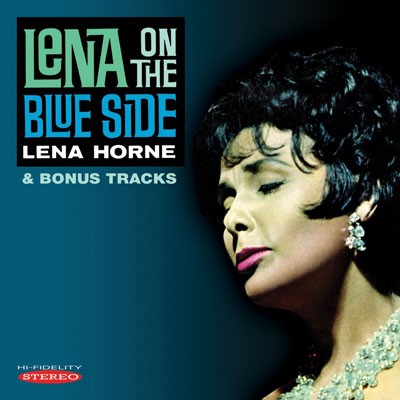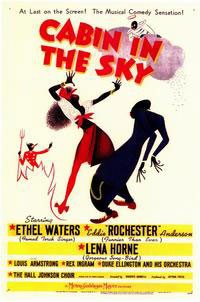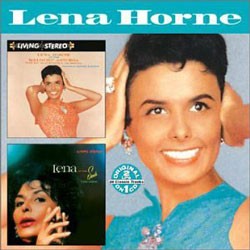Songbird Lena Horne is one of those musical phenomenons who come along once in a blue moon. She managed to sustain a stellar singing career for 60 years. Very few performers can claim that, and perhaps only Frank Sinatra, Ella Fitzgerald, and Tony Bennett approach that landmark number.
Lena Horne was born in Brooklyn in 1917 but was raised in the South by her mother. She left school and returned to New York at age 16 to get a job as a dancer at the famous Cotton Club in Harlem. She later found a singing gig with Noble Sissle’s Orchestra on the road. She entered a disastrous marriage at age 19 to Louis Jordan Jones and had two children, Ted and Gail Jones. Her marriage lasted from 1937 to 1944. In order to support her two children after her divorce, she got a job singing with Charlie Barnett’s Orchestra. She had her first hit recording with him. This led to her becoming a solo act at Cafe Society and other fancy cabarets of the forties.
When she was on tour in Los Angeles and playing at The Little Troc nightclub, MGM musical arranger Roger Edens caught her act and liked what he saw. He took her over to MGM and, at the urging of agent Louis Schurr and great MGM musical producer Arthur Freed, had her sing a few songs at the studio. Mogul Louis B. Mayer was brought in to listen to her, and he went crazy! Consequently, Lena made a screen test and was signed to a contract in 1941. The very first film that Lena appeared in was Panama Hattie in which she had a guest shot singing “Just One Of Those Things.” Lena’s number was staged by young Vincente Minnelli, who had just arrived in Hollywood himself.
Lena, of course, was a sensation. Alas, she received no screen credit! Panama Hattie had been a hit on Broadway with Ethel Merman and Betty Hutton. It was filmed with Ann Sothern and Virginia O’Brien in the Merman and Hutton roles. This un-billed ‘guest appearance’ was a preview of how most of Lena’s career at the studio would unfold. Lena’s aborted attempt at stardom wasn’t because she wasn’t any good. On the contrary, she was an original and she was terrific. The problem was that this was the early forties, and black performers had been relegated to playing maids, skycaps, and buffoons. Lena would have none of that because she had talent and beauty as well as integrity.
Roger Edens and Arthur Freed wanted Lena because she was simply the classiest performer of the day and not because she was black. This was an era when blacks were segregated from whites in hotels, restaurants, and even drinking fountains! This unfortunate trend even applied to famous black entertainers who often had to stay at lesser hotels than the white stars. In any case, MGM is to be congratulated for at least attempting to bypass the inherent bigotry that was standard procedure in many parts of America in the 1940s.
Vincente Minnelli’s first assignment as a director at MGM was to be the musical version of the stage hit Cabin In The Sky. It was to be the first all-black mainstream musical film in Hollywood. There was a lot of opposition to it because a previous all-black film, Green Pastures, made at Warner Bros, was not well-received by the leaders of the then-called Negro community. However, Producer Arthur Freed was determined to show black people in a humorous and dignified way.
The Broadway show starred singer Ethel Waters as Petunia, and she was signed to repeat her role in the film version. Miss Horne was signed to play the young vixen Georgia Brown. In the stage version, this was purely a dancing part as played by Katherine Dunham. The studio tailor-made it for Lena as a singing part. Others in the cast were Eddie ‘Rochester’ Anderson, Louis Armstrong, Duke Ellington, and Rex Ingram as the Devil. In a nutshell, the plot of the film was Petunia’s efforts to save her gambling, sinning husband Rochester from the Devil and to get his soul into Heaven.
One of Lena’s numbers from Cabin In The Sky was “Honey In The Honeycomb.” The Devil devised a scheme to lead poor Rochester as ‘Little Joe’ astray with Georgia Brown. An interesting sidelight to the filming of the picture was that star Ethel Waters didn’t like Lena Horne at all. Oh, the bitch fights! There were tensions and jealousies on the sound stage. Miss Waters, by this time, was a little rotund and broad at the beam. She looked like a barge coming down the Nile! She was terribly jealous of the beautiful and young Miss Horne. Remembering when she herself was the ingenue, Miss Waters wasn’t about to be outshone by the young upstart!
Director Minnelli was determined to show the black race in the most beautiful of terms. He had rages with the art department over the sets, especially the one for Lena’s bubble bath scene for “Ain’t it The Truth.” Minnelli had earned a well-deserved reputation on Broadway for being a brilliant stage designer, and he liked to see things in a beautiful and glamorous way. It was the first complete film that he had directed. Minnelli insisted that Lena appear in the scene as sexy, glamorous, and beautiful. “Ain’t It The Truth” showed Lena singing provocatively in a bubble bath. The scene never appeared in Cabin In The Sky. The censors were very strict in the forties, and they pressured producer Freed to cut the scene because it was too hot! It didn’t see the light of day until it appeared in That’s Entertainment III in 1994, fifty years after it was filmed!
Cabin In The Sky was the only film at her home studio in which Miss Horne played a leading role with spoken lines, despite the fact that she was under contract to MGM for fifteen years! Other interesting notes about Cabin In The Sky is only three of the songs from the original songwriters of the stage version were used in the film. Vernon Duke and John LaTouche penned “Taking A Chance on Love,” “Honey in The Honeycomb,” and “Cabin In The Sky.” The score was supplemented by Wizard of Oz songwriters E.Y. “Yip” Harburg and Harold Arlen. The two men received an Oscar® nomination for their new song, “Happiness Is A Thing Called Joe,” as performed by Ethel Waters.
Given the names “Sepia Goddess” and “Bronze Venus,” Miss Horne’s beauty adorned films such as the programmer Spring Fever in 1943. In that film she was beautifully photographed and magnificently gowned, all for three minutes of screen time!
Miss Horne spent most of her time at MGM making cameo shots in other people’s pictures. She never considered herself a movie star. Yet her numbers always were the high points of the films in which she sang. Because of the racial climate in the forties, her scenes were made so that she never had contact with any of the white stars, never had any lines with them, and appeared out of the blue singing in lavish production numbers. These musical episodes could easily be cut out of the film so that Southern audiences wouldn’t be ‘offended!’ So much for racial tolerance in the 1940s!
In 1944, Lena made Broadway Rhythm, again only appearing in a couple of guest-starring musical numbers. The stars of the film were young and perky Gloria DeHaven, singer Ginny Simms, dancer George Murphy and fellow African-Americans Hazel Scott, the pianist, and Eddie Rochester Anderson. Some backstage gossip about Broadway Rhythm is that during this early part of Lena’s film career, she was frequently called upon to pass as ‘white’ or Spanish! In both “The Spring” number in Panama Hattie, which you remember as her first film, and in Broadway Rhythm she was outfitted in wild Carmen Miranda tutti fruiti gowns and a blaze of color to cash in on the then-current vogue for Latin American music! These were the only two times in which Miss Horne was dressed less than elegantly.
By 1946 Lena was wowing audiences with her appearances in films, even though they were brief glimpses of the talented singer. Nevertheless, her reputation was growing, and she stole every movie scene she was in despite the fact she was not the star. A perfect example of Lena’s scene-stealing ability is in her moving rendition of “Can’t Help Lovin’ Dat Man” in the Jerome Kern biopic, Till The Clouds Roll By in 1946. This was the only time Lena called her ethnic identity into focus. There was a 20-minute medley version of Show Boat in the film, and Lena played the mulatto character, Julie La Verne.
Six years after Lena sang “Can’t Help Lovin’ Dat Man,” MGM decided to film a full-length version of the great stage hit Show Boat in 1951. Lena campaigned for the role of the mulatto Julie LaVerne. MGM had other ideas. The studio cast a white woman, the beautiful Ava Gardner, as a woman who could pass for black. Go figure! They used a lot of dark make-up on Ava and spent a lot of money. They could have used Lena’s natural color and saved money on barrels of Max Factor Egyptian hue foundation that was troweled onto Miss Gardner.
Words and Music went before the cameras on the sound stages of MGM on April 4, 1948. This was allegedly the story of songwriters Richard Rogers and Lorenz Hart. Tom Drake played Rogers and Mickey Rooney played Hart. Others in the cast were Janet Leigh and Marshall Thompson. Making guest-starring shots were Judy Garland, June Allyson, Gene Kelly, Cyd Charisse and, of course, Lena Horne. This was another excuse for MGM to showcase all of its contract stars in a musical extravaganza in which the numbers had no relation to the so-called plot! Choreographer Robert Alton ‘moved’ Lena gracefully through her two nightclub numbers, “Where or When” and “The Lady is A Tramp.” Miss Horne credits long-time MGM music arranger Kay Thompson for helping her develop breathing methods while delivering a song. Kay, of course, was associated for a long time with Judy Garland at the studio.
Lena’s other segment in Words and Music was her classy version of “The Lady Is A Tramp.” It’s one of her best turns on the screen, and the song has become identified with her despite Frank Sinatra’s fifties hit recording of the tune. Lena gives us all a singing lesson with her smashing version.
This has been a brief glimpse of the career of Lena Horne when she was under contract at MGM. Despite the way she was mistreated at the studio and not given leading roles, her performances are a testament to her talent. She set the screen on fire merely with her talent and captivating presence.









